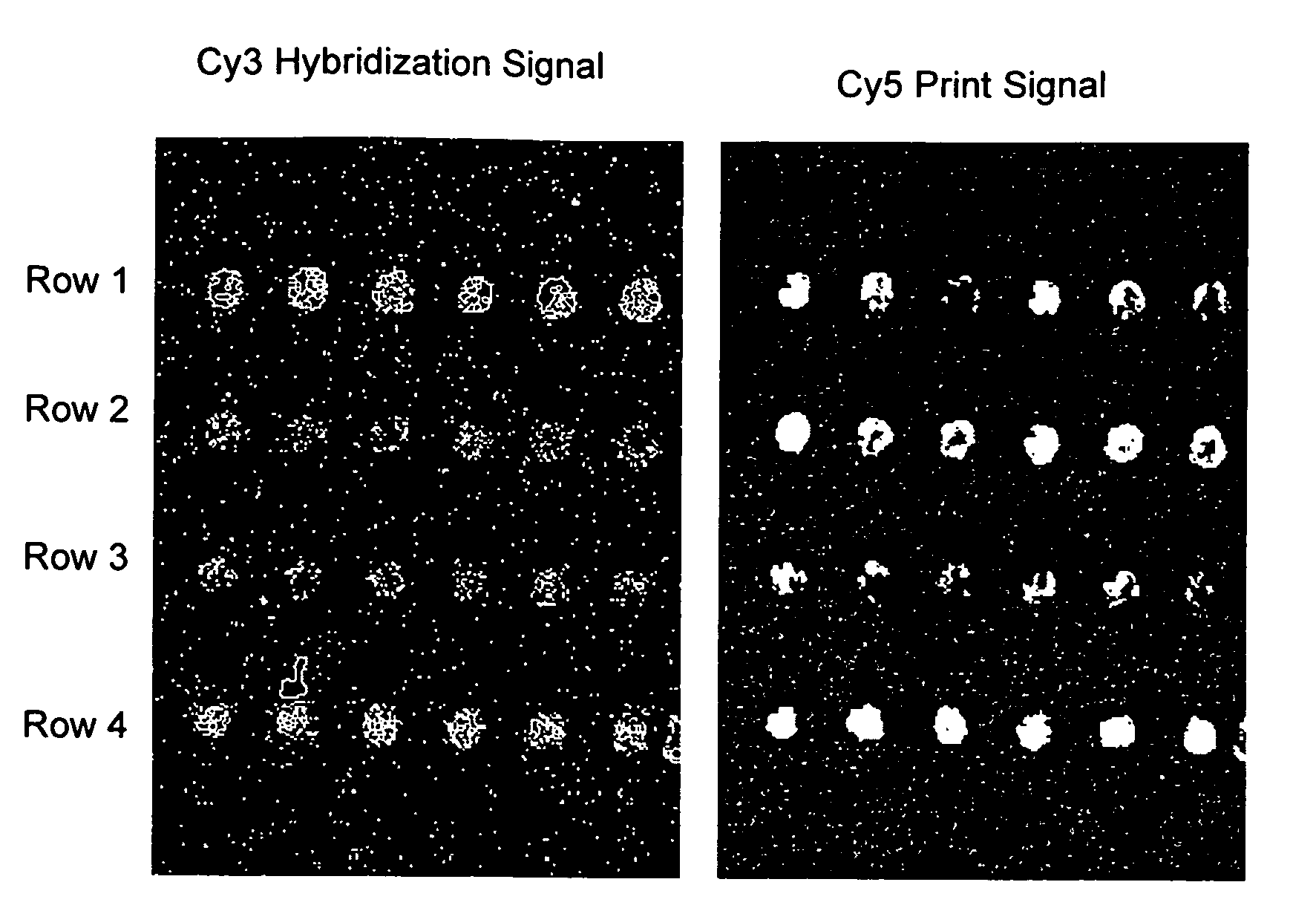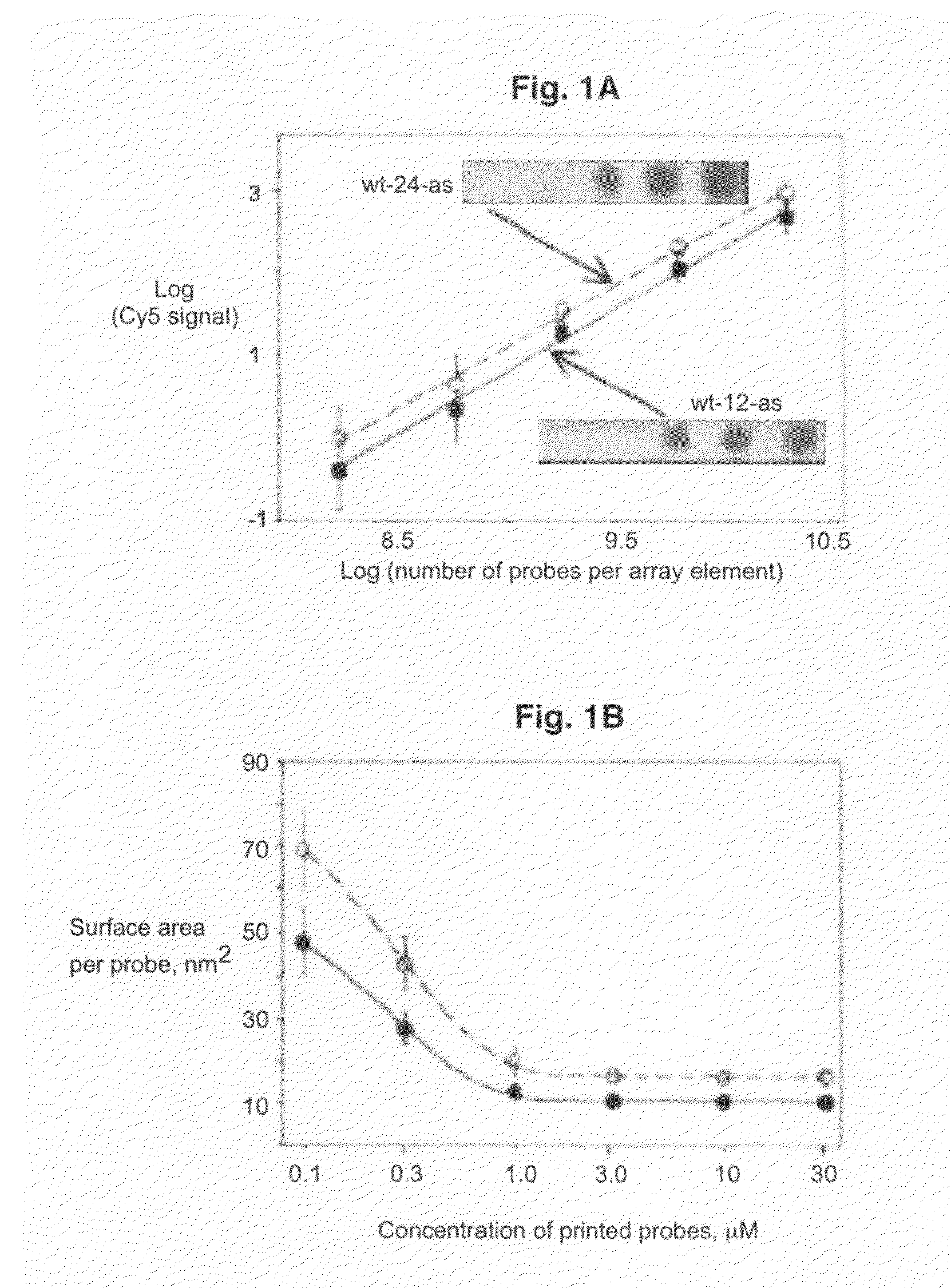Methods and devices based upon a novel form of nucleic acid duplex on a surface
- Summary
- Abstract
- Description
- Claims
- Application Information
AI Technical Summary
Benefits of technology
Problems solved by technology
Method used
Image
Examples
example 1
Aminosilanization of a Glass Surface
[0082]Glass, pre-cleaned, micro slides (Gold Seal, Gold Seal Products) were cleaned in deionized water, followed by rinsing in HPLC-grade methanol and dried in dust-free oven at 45 C. The slides were transferred to a vacuum oven at 82 C, equilibrated against 3-aminopropyltrimethoxysilane (Aldrich) in 1:2 proportion to p-xylene (Aldrich). The slides were then incubated overnight at 27 mm Hg, followed by storage at room temperature under dust free conditions.
example 2
Fabrication of Arrays
[0083]All oligodeoxyribonucleotides were synthesized, labeled with Cy3 or Cy5 fluorescent dyes at the 5′-ends, and HPLC purified by BioSource International (Camarillo, Calif.). A Microlab 4200 robot (Hamilton) with 10 ml syringes was used to print 6×8 arrays on aminosilanized glass slides: 10 nl volume per array element, 500 mm diameter, 900 mm center to center. Oligodeoxyribonucleotides were printed from 384 well plates (NUNC) at the desired concentration in 70% DMSO (Aldrich) / 30% H2O. DMSO inclusion in the printing solution slowed the process of drying and therefore resulted in more uniform probe density within the array elements as compared to printing the probes in water. After printing, arrays were washed in 10 mM NaOH, 100 mM Na+ carbonate, 2% polyvinyl alcohol, 5×Denhardts for 1 min, then rinsed multiple times in deionized H2O, and dried for storage. All procedures were performed at room temperature.
example 3
Hybridization and Imaging
[0084]Hybridization was carried out in the following hybridization buffers: 90 mM Na+ carbonate, 5×Denhardts, pH=9.5 for 12-mer targets and 60 mM Na+ carbonate, 5×Denhardts, 20% formamide, 0.6% polyvinyl alcohol, pH=9.5 for 24-mer targets. The pH has been held at 9.5 throughout in order to reduce surface charge due to free amino groups. Before hybridization, the arrays were pretreated in corresponding hybridization buffers without the targets, containing 1.5% (w / v) polyvinyl alcohol (Aldrich), used as a blocking agent. All steps were done at room temperature. After 10 minutes of hybridization, the slides were washed in corresponding hybridization buffers, rinsed several times in deionized water, dried, and imaged.
[0085]The arrays were imaged on a CCD based Arrayworx Imager (Applied Precision, Inc.) with 10 mm resolution. Cy3 and Cy5 optical filters were used during the imaging of the arrays. Exposure times were held at 0.2 sec for Cy3 channel and 1 sec for C...
PUM
| Property | Measurement | Unit |
|---|---|---|
| ionic strength | aaaaa | aaaaa |
| pH | aaaaa | aaaaa |
| diameter | aaaaa | aaaaa |
Abstract
Description
Claims
Application Information
 Login to View More
Login to View More - R&D
- Intellectual Property
- Life Sciences
- Materials
- Tech Scout
- Unparalleled Data Quality
- Higher Quality Content
- 60% Fewer Hallucinations
Browse by: Latest US Patents, China's latest patents, Technical Efficacy Thesaurus, Application Domain, Technology Topic, Popular Technical Reports.
© 2025 PatSnap. All rights reserved.Legal|Privacy policy|Modern Slavery Act Transparency Statement|Sitemap|About US| Contact US: help@patsnap.com



